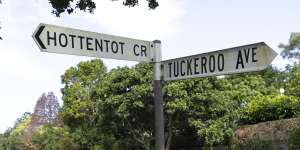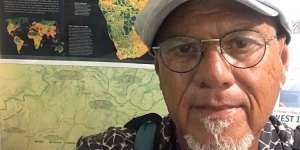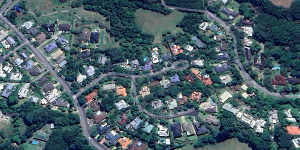Hottentot Crescent in Mullumbimby is poised to be rechristened “Moonlight Close” after Byron Shire Council decided that retaining the name Hottentot,a racial slur for indigenous people of South Africa,was no longer appropriate,and residents ruled out other options including “Drunken Parrot Place”.

Byron Shire Council is poised to change the name of Hottentot Crescent in Mullumbimby.Danielle Smith
The street is home to 23 residences and is part of a housing estate that was developed in 1993 with botanically themed street names. “Hottentot” refers toSchotia brachypetala,which is also known as the Hottentot bean tree,a South African tree that grows on the crescent.
Byron Bay resident Jonny Simons,who emigrated from South Africa in the 1980s,triggered the name change debate last year when a fellow South African happened upon the street while driving an Uber and told him about it. Simons wrote to the council imploring it to change the name and broke down in tears when addressing a council meeting on the issue in February.

Byron resident Jonny Simons,who advocated for Hottentot Crescent to get a new name.Supplied
“I grew up under apartheid and I am very aware of what that name means because it was a name my people were called. It was shortened to hot-tots … to make you feel inferior,” Simons said. “Only if you or your family were called those things can you fully understand what it means.”
But 12 residents on the street wrote to council objecting to the proposed change,saying they were fond of the name Hottentot Crescent,and loved that it referenced the beautiful flowering tree that grew outside their homes. Five residents wrote in favour of a new name.
Resident Daisy Sturm said changing her address with every service provider and on all her legal documents would cost a fortune and might require a lawyer.
“Everything needs changing,for absolutely no reason,” she said.
“We’re very,very unhappy about it. I do not know anybody who says it’s a good idea ... When I moved here 25 years ago,I was told that’s the name of a tree,and I thought ‘That’s beautiful.’ All of a sudden,it’s unacceptable because,as I understand,one person who doesn’t even live here really objected.”
Despite the protests from residents,the council determined in November that more harm would come from retaining the name than changing it,especially in the digital age when it was easier for people to come across the name online and be offended.
‘[It’s] the name of a tree …[now] it’s unacceptable because one person who doesn’t even live here really objected.’
Hottentot Crescent resident Daisy Sturm
It began liaising with the Geographical Names Board to come up with a new moniker for the street,and is now poised to send Moonlight Close to the board to make the change official. The council was to endorse the new name at its meeting last week but deferred the matter due to lack of time.
Botanic Gardens of Sydney chief scientist Brett Summerell said the Royal Botanic Garden in Sydney had opted to use a different name for the tree.
“There’s a specimen down by the creek,heading down towards the restaurant,and every spring and summer it’s full of lorikeets getting drunk,basically,” he said.
“We call it the drunken parrot tree … that’s a much more interesting name than one that has a racist connotation,both to tell a story and to be more relevant to the Australian landscape.”

Hottentot Crescent in Mullumbimby.,the road in the centre ending in the loop. “Hottentot” refers to Schotia brachypetala,also known as the Hottentot bean tree,a South African tree that grows on the crescent.Google Earth
But he said it was easier to opt for a different common name for a species than to change its scientific name,which has to abide by strict rules,and debate has been swirling in scientific circles around whether,and how,to do that for controversially named flora and fauna.
“It will be a pretty hot topic at the International Botanical Congress in Madrid in July,” he said. “The scale is just so huge. There are estimates that 20-30 per cent of flora and fauna in all parts of the world are named after colonial figures.”
University of Sydney history professor Kirsten McKenzie said “Hottentot” was an offensive term founded on ignorance and racism. She said Dutch colonisers who coined the word had killed the indigenous men to whom it referred,and taken women and children into forced labour.
“It was born out of a time of frontier warfare,” she said. “These exterminatory wars were devastating across the 1700s and 1800s.”
The Geographical Names Board receives about a dozen requests to rename roads each year,and said place naming should reflect community standards which can change over time.
NSW Aboriginal Land Council chairman Ray Kelly said there were many racist place names in NSW that should be changed.
“Some of these sites are where Aboriginal men,women and children were massacred. Imagine going past these names every day and feeling the pain in your heart.”
Simons said he did not hold any ill will towards the residents of Hottentot Crescent who had objected to the name change.
“I do not blame anybody in that street for standing up and wanting to keep that name,because they didn’t know what it meant,” he said. “They thought it was the name of a tree,but that tree was named as such because the Khoisan people of South Africa ate the fruit of that tree.”
Start the day with a summary of the day’s most important and interesting stories,analysis and insights..